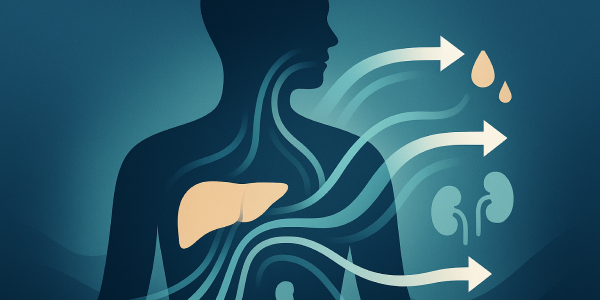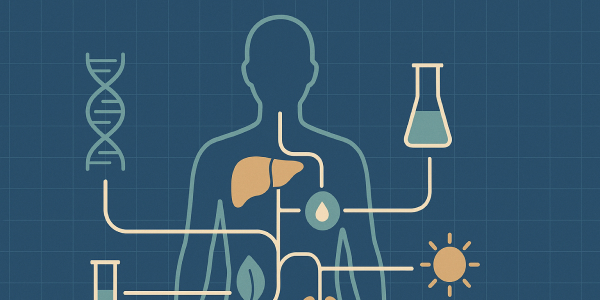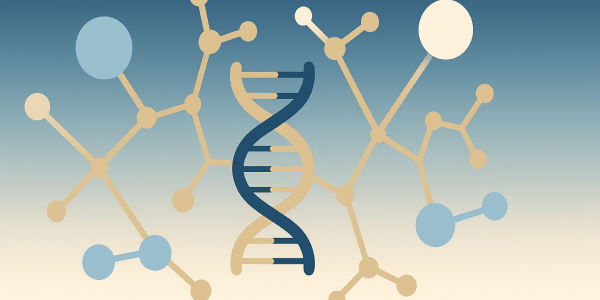Methylation and Physical Health: Detox, Heart, Hormones & Longevity


The first three articles in this series on the Methylation Pathway have built us a solid foundation. We've covered what methylation is, how the gene network functions, and why it profoundly impacts mental health and stress resilience. Now, we're turning our attention to the physical body. The same methylation pathways that influence your mood and cognitive function are also the unsung heroes of cardiovascular health, detoxification, hormone balance, and even how well you age. When methylation functions optimally, these systems hum along quietly in the background. When it doesn't, the effects can show up as unexplained emotional dysregulation, elevated disease risk, hormonal chaos, toxic burden, and accelerated aging.
Let's explore how methylation shapes your physical health, and why supporting these pathways might be one of the most powerful things you can do for longevity and vitality.
Cardiovascular Health: The Homocysteine Connection
One of the most well-established links between methylation and physical health is cardiovascular disease. The culprit? Homocysteine.
What Is Homocysteine and Why Does It Matter?
Homocysteine is an amino acid produced during the methylation cycle. Under normal circumstances, it's quickly converted into either methionine (via MTR and MTHFR) or cysteine (via CBS). But when methylation pathways are impaired, due to genetic variants, nutrient deficiencies, or both, homocysteine accumulates in the blood.
Elevated homocysteine is an independent risk factor for:
- Cardiovascular disease: Damages blood vessel walls, promotes plaque formation, increases clotting risk
- Stroke: Contributes to both ischemic and hemorrhagic stroke risk
- Deep vein thrombosis and pulmonary embolism: Increases blood clot formation
- Cognitive decline and dementia: Homocysteine is neurotoxic and associated with brain atrophy
- Pregnancy complications: Linked to preeclampsia, recurrent miscarriage, and neural tube defects
The MTHFR connection: People with MTHFR C677T variants, especially homozygous (two copies), frequently have elevated homocysteine, sometimes significantly so. This is why cardiovascular disease often runs in families with MTHFR variants.
The intervention opportunity: Homocysteine is one of the most modifiable cardiovascular risk factors. Optimizing folate (B9), B12, B6, and B2 can often normalize levels, even in people with genetic variants. This is preventive medicine at its finest.
Testing and Target Ranges
Homocysteine should ideally be between 6-9 μmol/L. Many functional medicine practitioners aim for under 7 μmol/L for optimal health.
Levels above 15 μmol/L are considered high and warrant immediate intervention. Levels above 30 μmol/L significantly increase cardiovascular and neurological risk.
Important note: Standard medical practice often considers homocysteine "normal" up to 15 μmol/L, but research shows cardiovascular risk increases even within the "normal" range. Don't assume you're fine just because your doctor didn't flag it.
Detoxification: Methylation as Your Cellular Cleanup Crew
Your liver is the primary detoxification organ, and methylation is one of its most critical pathways. When you're exposed to environmental toxins, heavy metals, medications, alcohol, or even normal metabolic byproducts, your liver uses methylation to make these substances water-soluble so they can be excreted.
Phase II Liver Detoxification
Liver detoxification occurs in two main phases:
- Phase I: Cytochrome P450 enzymes transform toxins into intermediate compounds (often more reactive and potentially harmful)
- Phase II: Conjugation reactions, including methylation, neutralize these intermediates and prepare them for elimination
If Phase I is working but Phase II methylation is impaired (common with MTHFR and other variants), toxic intermediates can accumulate. This is why some people with methylation issues feel worse when exposed to chemicals, have severe hangovers, or react badly to medications.
What Gets Methylated for Detoxification?
Your body methylates and eliminates:
- Heavy metals: Arsenic, mercury, lead
- Environmental toxins: Pesticides, plastics, industrial chemicals
- Medications: Many drugs require methylation for breakdown
- Hormones: Excess estrogen, thyroid hormones
- Neurotransmitters: As discussed in Article 3
- Histamine: Methylation clears histamine (relevant for allergies, mast cell issues)
Clinical patterns: People with impaired methylation often report:
- Chemical sensitivities or multiple chemical sensitivity (MCS)
- Severe reactions to alcohol (worse hangovers, inflammation)
- Medication side effects or poor drug metabolism
- Mold or environmental illness
- Histamine intolerance
This isn't "just being sensitive", it's impaired detoxification at the biochemical level.
The Glutathione Connection
Remember CBS, the gene that shunts homocysteine down the transsulfuration pathway? That pathway leads to the production of glutathione, your body's master antioxidant and a critical detoxification molecule.
When methylation and transsulfuration are both impaired, glutathione production suffers. Low glutathione means:
- Reduced antioxidant defense (more oxidative stress and cellular damage)
- Impaired detoxification (especially of fat-soluble toxins and heavy metals)
- Increased inflammation and immune dysfunction
- Accelerated aging
Supporting methylation often improves glutathione status, and vice versa, they're intimately connected.
Hormone Balance: Methylation as the Regulator
Methylation doesn't just clear hormones, it influences their production, activation, and regulation. This is especially relevant for estrogen, thyroid, and testosterone.
Estrogen Metabolism: The COMT Connection
Estrogen must be methylated for proper clearance. The enzyme COMT (which we discussed in Article 3 regarding neurotransmitters) also methylates estrogen metabolites.
When methylation is impaired:
- Estrogen clearance slows
- Estrogen metabolites accumulate, especially the more problematic 4-hydroxy and 16-hydroxy forms
- Risk increases for estrogen dominance symptoms: heavy periods, PMS, breast tenderness, fibroids, endometriosis
- Long-term: Increased risk for estrogen-related cancers (breast, ovarian, uterine)
Why this matters for both men and women: Men need to clear estrogen too. Impaired methylation in men can contribute to gynecomastia (breast tissue development), low libido, and increased cardiovascular risk from estrogen imbalance.
COMT variants compound the issue: Slow COMT variants mean even slower estrogen clearance. Combined with MTHFR and low SAMe, this creates a perfect storm for hormonal issues.
Thyroid Function
Thyroid hormones require methylation for:
- Proper conversion of T4 (inactive) to T3 (active)
- Regulation of thyroid hormone receptors
- Clearance of excess or spent thyroid hormones
People with methylation impairment often present with:
- Hypothyroid symptoms despite "normal" labs
- Poor conversion of T4 to T3
- Thyroid medication that doesn't seem to work well
- Elevated reverse T3 (inactive form)
Addressing methylation can sometimes improve thyroid function dramatically, even without changing thyroid medication.
Testosterone and Androgens
Methylation influences androgen metabolism as well. This is particularly relevant for:
- PCOS (polycystic ovary syndrome) in women
- Benign prostatic hyperplasia (BPH) in men
- Overall hormonal balance and libido in both sexes
Longevity & Cellular Health: Methylation's Role in How You Age
Perhaps the most exciting area of methylation research is its connection to aging and longevity.
DNA Methylation Patterns and Epigenetic Age
Your "biological age" isn't just determined by the years you've lived, it's also determined by your DNA methylation patterns. Researchers have developed "epigenetic clocks" that measure methylation patterns across your genome to estimate biological age.
Key findings:
- People with optimal methylation patterns tend to have younger biological ages
- Lifestyle factors that support methylation (nutrition, exercise, stress management, sleep) can slow or even reverse biological aging markers
- Poor methylation accelerates epigenetic aging
This isn't theoretical, it's measurable, and it matters for disease risk and lifespan.
Mitochondrial Function and Energy Production
Mitochondria, your cellular power plants, rely on methylation for:
- Producing key energy molecules
- Repairing mitochondrial DNA
- Regulating oxidative stress
- Supporting healthy mitochondrial turnover (mitophagy)
Impaired methylation often manifests as:
- Chronic fatigue that doesn't improve with rest
- Poor exercise recovery
- Metabolic inflexibility (difficulty switching between fuel sources)
- Accelerated aging
This is why many people with methylation issues describe feeling "older than their years" or having severe, unexplained fatigue.
Telomere Length
Telomeres are protective caps on the ends of your chromosomes that shorten with each cell division. Shorter telomeres are associated with aging and disease risk.
Methylation influences:
- Telomere maintenance and repair
- The activity of telomerase (the enzyme that rebuilds telomeres)
- Overall genomic stability
Supporting methylation may help preserve telomere length, though this area needs more research, the connections are promising.
Cellular Repair and Autophagy
Autophagy is your body's cellular "recycling program", it clears out damaged proteins, organelles, and cellular debris. Methylation supports autophagy and cellular repair mechanisms, which are critical for:
- Preventing cancer (clearing damaged or precancerous cells)
- Maintaining tissue health
- Supporting immune function
- Promoting longevity
Inflammation: The Common Thread
If there's one unifying theme across all these physical health connections, it's inflammation.
Impaired methylation promotes inflammation through:
- Elevated homocysteine (vascular inflammation)
- Poor detoxification (toxin-driven inflammation)
- Hormone imbalances (estrogen dominance, thyroid dysfunction)
- Reduced glutathione (oxidative stress)
- Mitochondrial dysfunction (cellular stress)
Chronic inflammation, in turn, is the root cause of most chronic diseases:
- Cardiovascular disease
- Autoimmune conditions
- Metabolic syndrome and diabetes
- Neurodegenerative diseases (Alzheimer's, Parkinson's)
- Cancer
By supporting methylation, you're addressing inflammation at a fundamental level, not just masking symptoms but improving the underlying biochemistry.
The Methylation-Longevity Connection: Putting It All Together
When you support methylation effectively, you're essentially optimizing multiple longevity pathways simultaneously:
✓ Cardiovascular protection (lower homocysteine, reduced clotting risk)✓ Enhanced detoxification (lower toxic burden, reduced cellular damage)✓ Balanced hormones (reduced disease risk, better quality of life)✓ Optimized mitochondrial function (more energy, better cellular health)✓ Reduced systemic inflammation (lower chronic disease risk)✓ Improved DNA repair and epigenetic health (slower biological aging)
This is why methylation support isn't just about feeling better today, it's an investment in your healthspan and lifespan.
What This Means for Your Health Journey
Understanding these connections helps you see methylation not as an isolated genetic quirk but as a central player in your long-term health. Whether you're dealing with current health issues or focused on prevention and longevity, methylation deserves attention.
The good news? Unlike many aspects of health that feel out of your control, methylation is highly responsive to targeted nutrition, lifestyle, and strategic supplementation.
In our final article, we'll bring everything together with practical, actionable strategies. You'll learn exactly how to support your methylation pathways through food, supplements, lifestyle modifications, and testing, so you can turn knowledge into tangible results.











.svg)